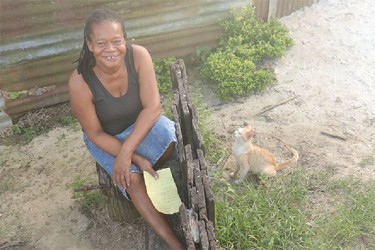By Jeanna Pearson with photos by Arian Browne
A small community of approximately 800 people, Kaneville is buried deep behind the Grove Housing Scheme on the East Bank Demerara. It is also called ‘Bruk-it-Down Village’, because of its loam roads with huge craters in every street.
According to residents, the rugged terrain invites motocross racing, which turns the roads into danger zones at night.
The village has no street lights and because of the gigantic basins in the roads, public transportation is scarce and the cost of a taxi is higher than the average daily wage. Residents are left to brave being robbed as they endeavour to reach their homes, hurrying past overgrown canals with caimans and snakes.


Yet, snakes are not strange to the villagers: many have them as pets in their homes. Sanchez, a sculptor in his fifties, has a pet rainbow boa constrictor. He calls the large snake ‘Bubbles’.
Sanchez was one of the first residents of Kaneville. He moved there to avoid paying rent and to own his own home. “I use to rent a place in Waterloo Street and then I got the opportunity to own my own house and so I moved. I love living here because it is a peaceful community—except in the night; it’s dangerous on the roads for people coming home,” he said.
He said when he first moved to the area, it was covered in bushes and most people had zinc houses. But as the years passed, wood houses were built and more people moved into the village. Kaneville is predominantly a mixed race community.
Asked why he loved living in the village, Sanchez answered “Don’t you feel it?” He was talking about the air. He said the place is very breezy in the daytime and cold at night.
Sanchez, however, complained about the muddy roads with huge craters. “I think we have the biggest potholes in the country. And when it rains they are like big basins with water,” he said, adding that the absence of street lights and the growing number of petty robberies have given the place a bad name.
He said people recognize the village by the words “wrong turn,” which is actually a street where many of the youths in the neighbourhood “lime”.


“We need better roads and street lights at the back here because it’s not a safe area to come in the nights,” he said.
Carlos Hedley, a minibus driver, said he has been living in the neighbourhood for over ten years and the condition of the place has not changed a bit. Roads haven’t been repaired in eight years, canals haven’t been cleaned and garbage is left to litter on the sides of trenches.
He said their discomfort outweighs their love for living in the village. Hedley stated that many minibus drivers and taxi drivers would refuse to take people into the village because of the collapsing roads.
“You think it is fair to have to fix you bus every month for a couple dollars? My bus has been in the workshop for over a month now The roads bruk up my wheel bearings,” he said, adding that the relevant authorities need to do something quick about the condition of the roads.
“We would appreciate it if they could do something about it because it bruking up our buses and cars,” he stated.
Hedley contended that the government does not appear to be concerned about their plight or it would have done something a long time ago. “Look, six months now a pipe burst over the canal

and no one ain’t come to fix it. These people don’t care about what goes on in here,” he said.
Annie Richardson said her eight years of living in Kanevillle have been spent in fear. She said she moved to the village with her five children to take up residence on a piece of land next to a canal. And many days she would be sitting in her living

room with her children and a snake would crawl into the room.
“I use to be fearful that snakes would come in and bite my children when they were young. Up to this day I still worry if they would come in the house because the bush in the trench is big and big anaconda and alligator live in it,” she said.
Kaneville has a lot shops but there are no places of worship. Most of the children in the village attend schools in the Diamond Housing Scheme since there is no school in Kaneville. There is also no community centre or health centre and villagers would have to go to the Grove Health Centre for medical attention.
Ann Henry, who has lived in Kaneville for over 20 years, said she is very comfortable living there despite the crime and bad roads. “When I come here the whole place was canefield and we started to build piece, piece and live. But in all the years I ain’t find nothing wrong with here. The people are friendly and we get light and water,” Henry said.

She said she could spend the rest of her life in Kaneville just because of how kind the people are. “I love Kaneville,” she said.











